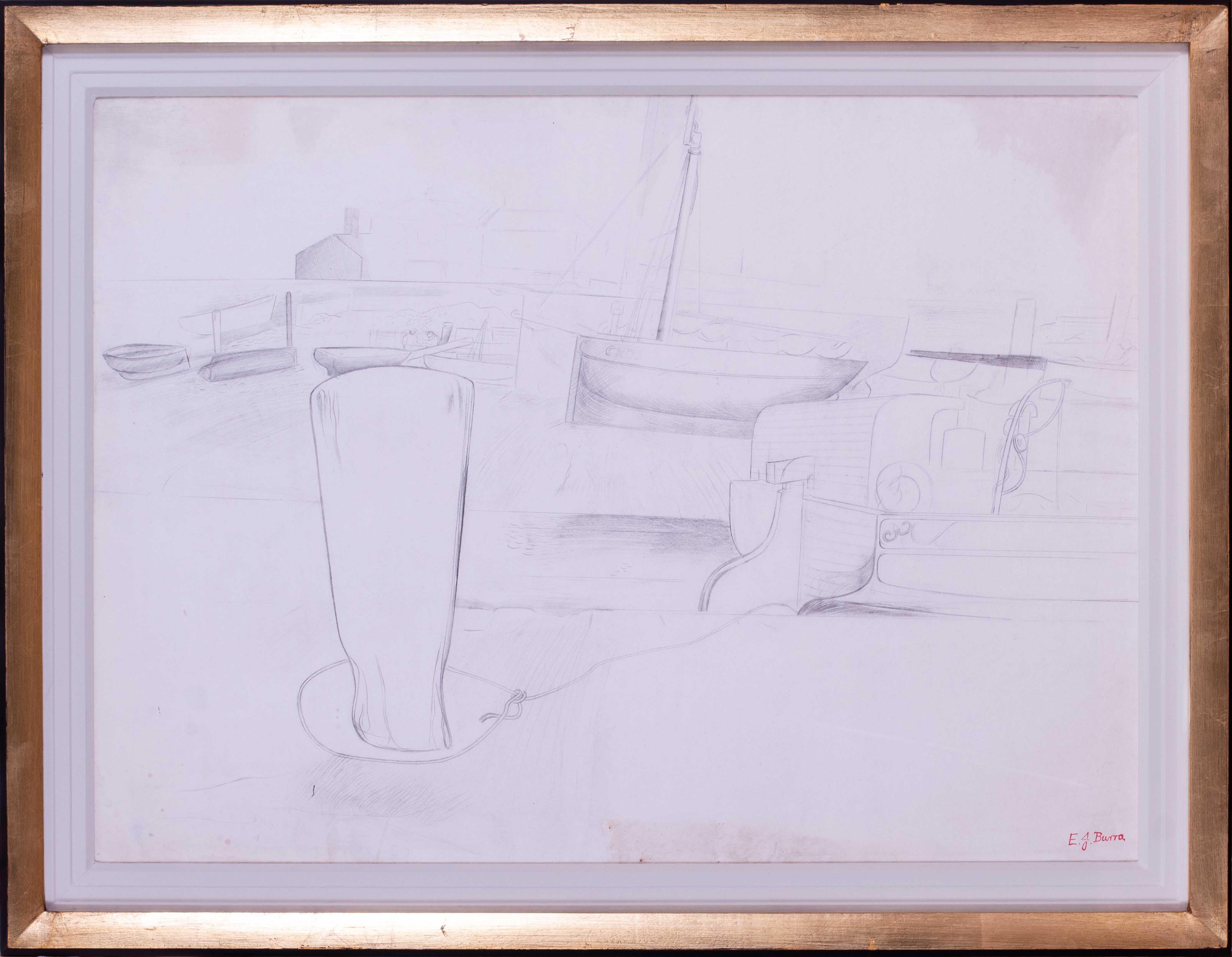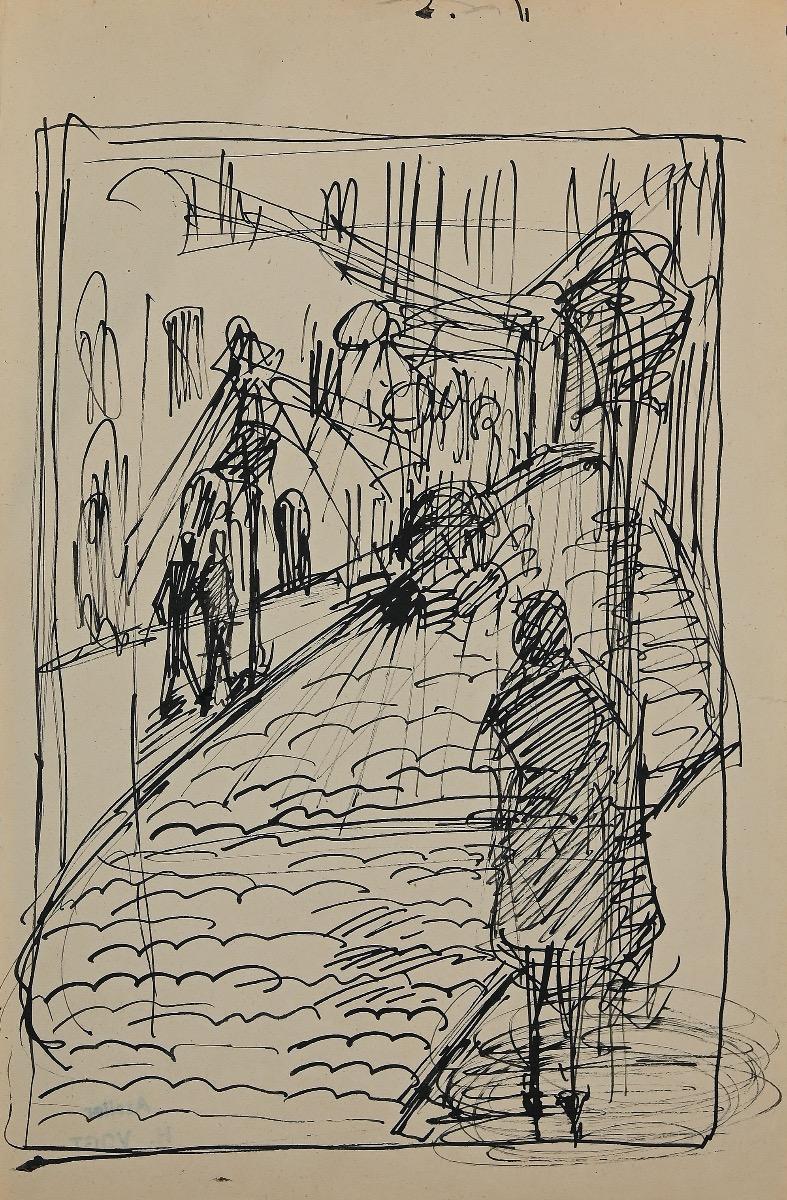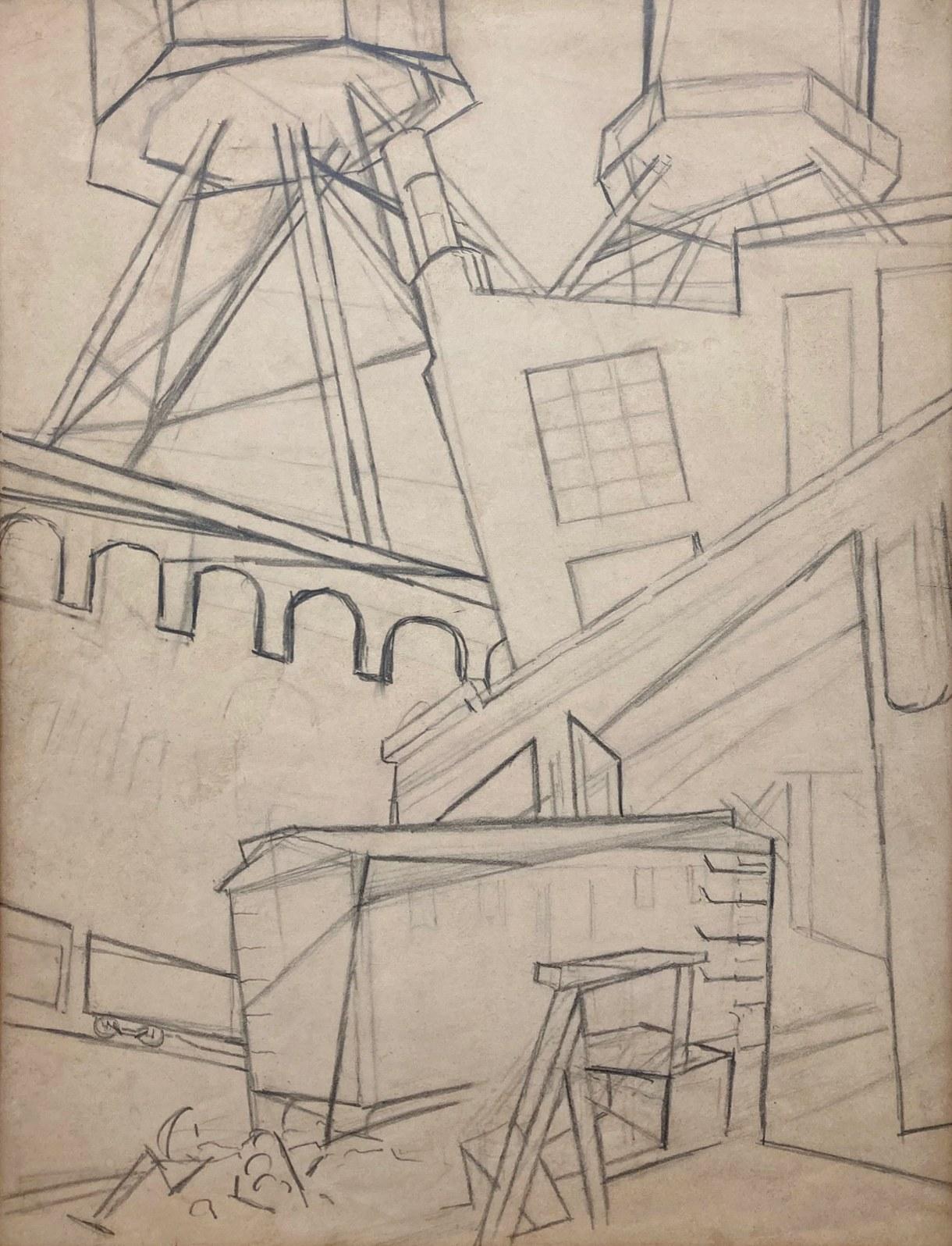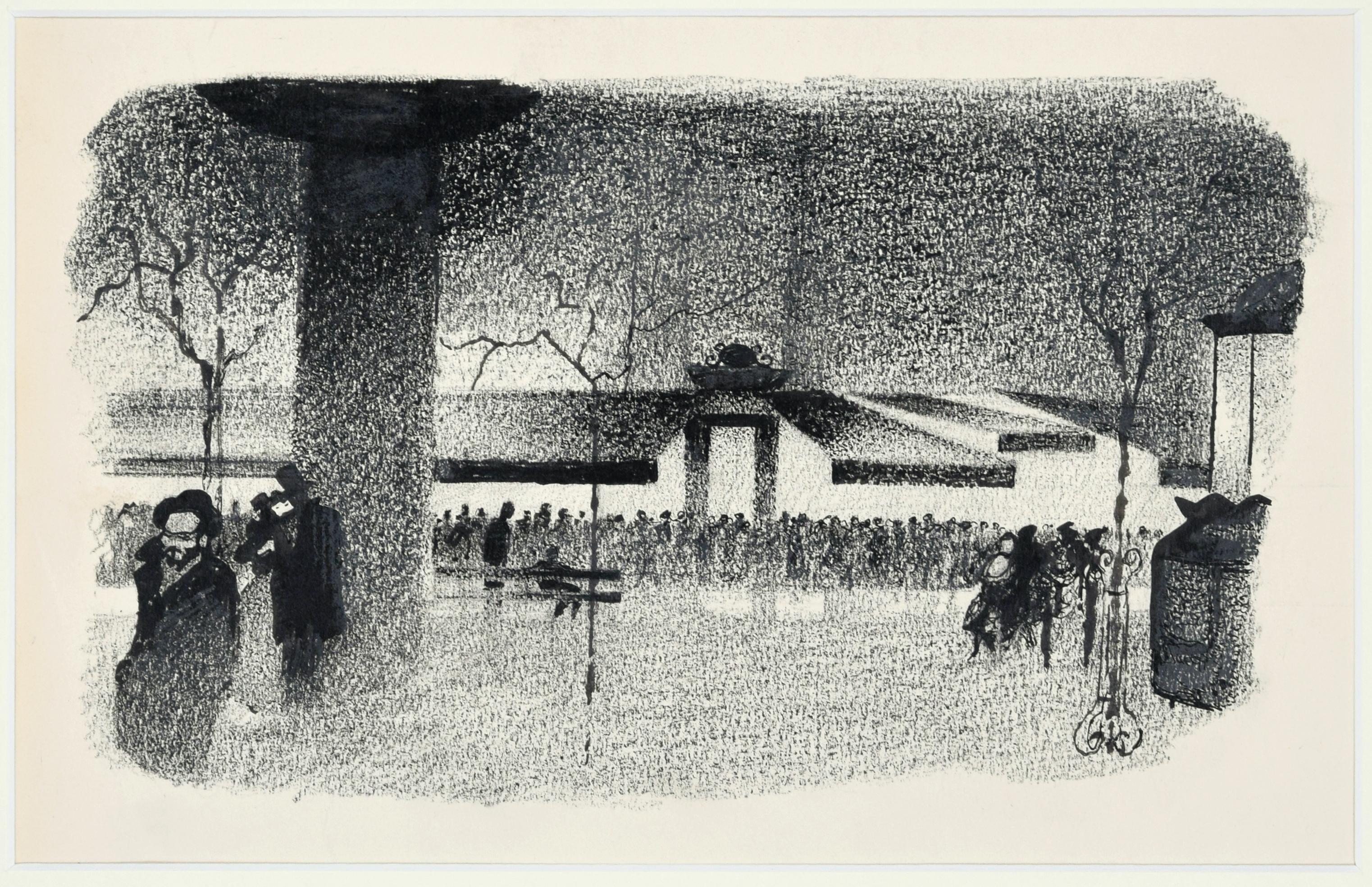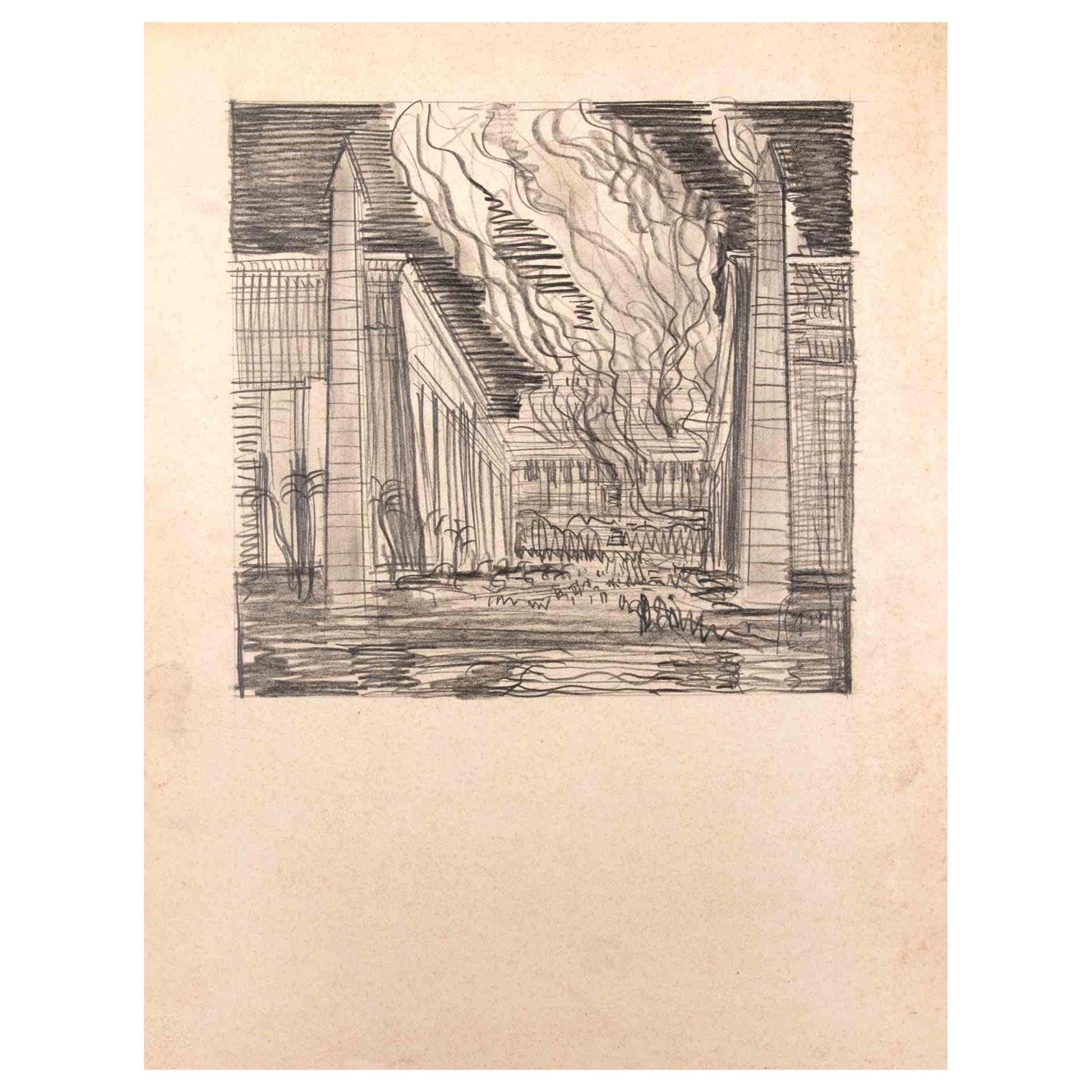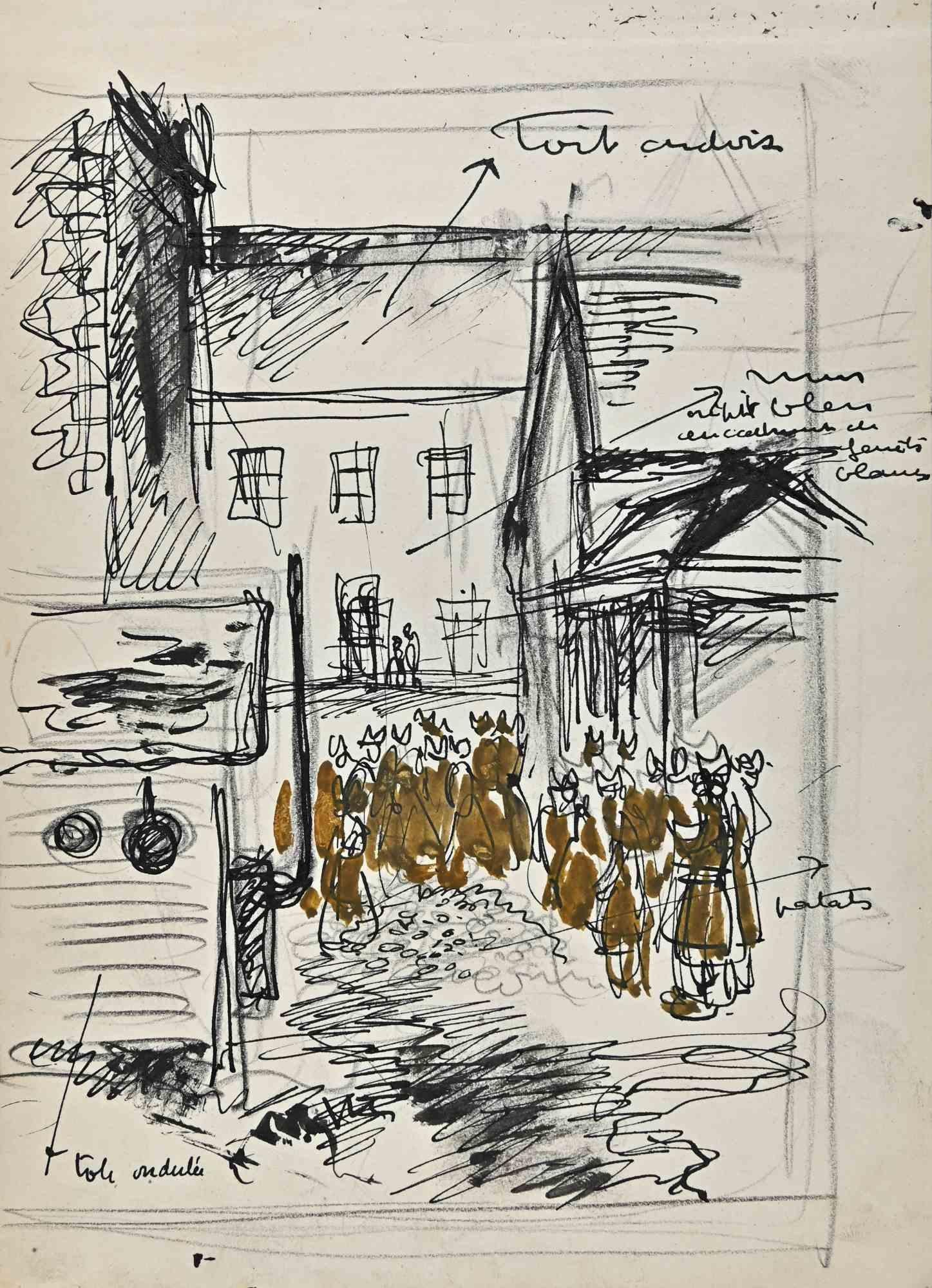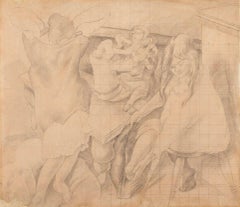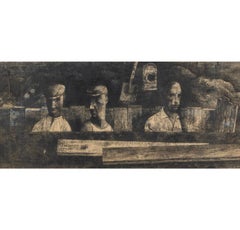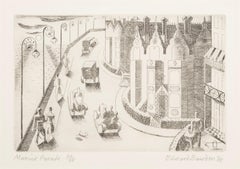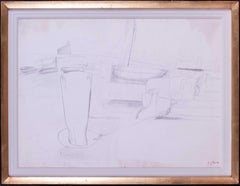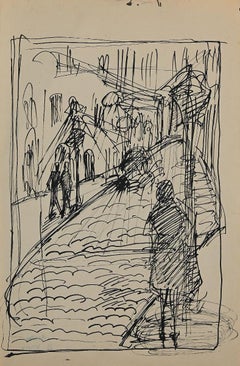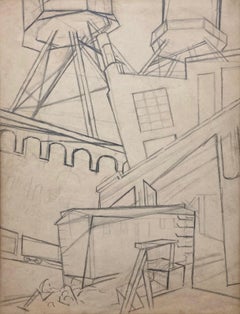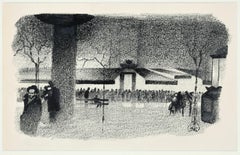Items Similar to Street Scene, Pencil Drawing by Edward Burra, 1930s circa
Want more images or videos?
Request additional images or videos from the seller
1 of 6
Edward BurraStreet Scene, Pencil Drawing by Edward Burra, 1930s circa1930 circa
1930 circa
Price Upon Request
Price Upon Request
Price Upon Request
Price Upon Request
Price Upon Request
Price Upon Request
Price Upon Request
Price Upon Request
Price Upon Request
Price Upon Request
About the Item
Street Scene, Pencil Drawing by Edward Burra, 1930s circa
Additional information:
Medium: Pencil drawing
49.5 x 61 cm
19 1/2 x 24 1/8 in
With Estate stamp
Painter in watercolour (frequently on a large scale) of sardonic genre and of scenes of violence and destruction; also landscapes and still life, often with macabre overtones. Burra was born on 29 March 1905 in South Kensington, London. He studied at Chelsea School of Art 1921-3 and the R.C.A. 1923-4. His first one-man exhibition was at the Leicester Galleries in 1929; he was a member of Unit One 1933, and exhibited with the English Surrealists 1936 and 1938. Burra travelled in Europe, the U.S.A. and Mexico and made designs for the Camargo Society's ballet Rio Grande 1931 and for several Sadler's Wells and Covent Garden productions. A.R.A. 1963.
- Creator:Edward Burra (1905 - 1976, British)
- Creation Year:1930 circa
- Dimensions:Height: 19.5 in (49.53 cm)Width: 24.125 in (61.28 cm)
- Medium:
- Period:
- Condition:
- Gallery Location:Kingsclere, GB
- Reference Number:1stDibs: LU2718214573362
About the Seller
No Reviews Yet
Vetted Professional Seller
Every seller passes strict standards for authenticity and reliability
Established in 2010
1stDibs seller since 2024
41 sales on 1stDibs
Typical response time: 7 hours
- ShippingRetrieving quote...Shipping from: Kingsclere, United Kingdom
- Return Policy
Authenticity Guarantee
In the unlikely event there’s an issue with an item’s authenticity, contact us within 1 year for a full refund. DetailsMoney-Back Guarantee
If your item is not as described, is damaged in transit, or does not arrive, contact us within 7 days for a full refund. Details24-Hour Cancellation
You have a 24-hour grace period in which to reconsider your purchase, with no questions asked.Vetted Professional Sellers
Our world-class sellers must adhere to strict standards for service and quality, maintaining the integrity of our listings.Price-Match Guarantee
If you find that a seller listed the same item for a lower price elsewhere, we’ll match it.Trusted Global Delivery
Our best-in-class carrier network provides specialized shipping options worldwide, including custom delivery.More From This Seller
View AllStudy for Going to Bed Drawing, Pencil on Paper by Stanley Spencer, 1935
By Stanley Spencer
Located in Kingsclere, GB
Study for Going to Bed Drawing, Pencil on Paper by Stanley Spencer, 1935
Additional information:
Medium: Drawing, Pencil on Paper
54.6 x 63.5 cm
21 1/2 x 25 in
This is a study for a painting featured in Spencer’s nine picture series, ‘Domestic Scenes’ (1935), throughout which the artist nostalgically reflected on and reimagined the marriage to his then-wife, Hilda Carline, following their separation after ten years together. Indeed, letters show that Hilda began divorce proceedings while the series was being produced, in part owing to Spencer’s infatuation with young artist Patricia Preece, who lived in Cookham alongside her partner Dorothy Hepworth. Spencer married Preece a week after the divorce was finalized, but the marriage was disastrous and his subsequent endeavors to reconcile with Hilda were also unsuccessful, although he did continue to visit her regularly until her death in 1950. Spencer saw the Domestic Scenes series as preparation for his 1953 painting ‘The Marriage of Cana’, a depiction of Christ’s first miracle, the turning of water into wine as described in St John’s Gospel, with the bride and groom reimagined as Stanley and Hilda.
This study has been exhibited widely, including at the opening exhibition of the Stanley Spencer Gallery, Cookham in 1962 and in the Royal Academy’s 1980 retrospective ‘Stanley Spencer: RA’. The completed painting, ‘Domestic Scenes: Going to Bed’ (1936) was included in the Barbican Art Gallery’s 1991 exhibition ‘Stanley Spencer: The Apotheosis of Love’, curated by John Toole...
Category
20th Century Still-life Drawings and Watercolors
Materials
Pencil
Italian Scene, Pen and Ink with Wash Painting by Reginald Brill, 1950s circa
By Reginald Brill
Located in Kingsclere, GB
Italian Scene, Pen and Ink with Wash Painting by Reginald Brill, 1950s circa
Additional information:
Medium: Pen and ink with wash
33 x 48.3 cm
13 x 19 in
Reginald " Reggie" Brill was a versastile 20th century artist and teacher.
Brill was born in London in 1902 and spent his early childhood there and in Yorkshire. By the time of the First World War, at the age of 13, he was living in lodgings in London, working in a City office and attending St Martins School of Art in the evenings. Considering his lack of education, winning a scholarship to The Slade (now part of University College London) in 1921 where he studied under Henry Tonks for three years, was a huge achievement.
On leaving The Slade he found patronage in Lincolnshire, but by the time of the General Strike (1926) he had returned to London and was working on Lansbury's Labour Weekly. He married Rosalie, also an artist, and in 1927 won the Prix de Rome in Decorative Painting. Following two years at The British School in Rome, Brill went to teach at Blackheath School of Art. During 1930 he spent three months painting in Egypt and it was there that he met Col. T G Gayer-Anderson, one of the twin brothers who were to bequeath The Little Hall in Lavenham as a hostel for art students. It was there that Brill retired to act as warden, thus continuing his nurturing of art students until his death in 1972.
Brill took up his appointment at The School of Art, Kingston upon Thames in January 1934. It was situated in the Technical Institute (Kingston Hall Road) and Brill found it bohemian and disorganised. He proceeded to inject enthusiasm, order and discipline. Within 5 years of his appointment a purpose-built School of Art was opened in Knights Park. It remained open throughout the war and by 1945 there was a waiting list for places. Under the skilled and totally dedicated direction of Brill, Kingston School of Art became established with national reputation for excellence. In 1961 Sir Charles Wheeler opened the new building at Knights Park. Costing £100,000, this more than doubled the size of the Art School.
Brill, was a well-known figure in Kingston. His eloquence made him popular as a guest speaker and his promotion of Art and Design stretched well beyond the doors of Knights Park. Apart from establishing two of the main buildings which makeup what is now known as the Faculty of Design, one of the most visible local contributions he made was the setting up of a topographical collection of paintings depicting Kingston, which has since become known as The Brill Collection at Kingston Museum. Brill gained huge respect and admiration from the hundreds of pupils who studied at Kingston during his 30-year leadership.
He published two books, Modern Painting 1946 and Art as a Career 1962, both bearing a strong educational angle. He regularly exhibited along with leading artists of his era at The Royal Academy, both his paintings and his acutely observed drawings. All the while he was a prolific artist, although reading his diaries, intensely self-critical. His perfectionism, acute powers of observation and relentless research can be seen in his drawings, which via the media and methods he explored throughout his life reflect mid 20th century British Art at its most typical. His major series of work, known as 'The Martyrdom of Man', was carried on in parallel to his career as a teacher. These paintings reflect his care for fellow man and depict people at work, e.g., The Operation, The Jury, Linemen, Waiting Room and Rest, which recently sold at Sotheby’s and was specially restored for The Brill Retrospective. His smaller works also play with the theme of everyday events and communication amongst people, such as The Bull Ring and Market Place paintings.
Brill's name is associated particularly with human figure compositions, but he also worked on landscapes, portraits and details of plants, animals, interiors etc. As one would expect he moved from one media to another, and his unusual hand painted and cut paper mosaics...
Category
20th Century Landscape Paintings
Materials
Pen
Study for Men in the Trench, Pen, Ink & Watercolour on Paper Painting 1950 circa
By Reginald Brill
Located in Kingsclere, GB
Study for Men in the Trench, Pen, Ink & Watercolour on Paper Painting 1950 circa
Additional information:
Medium: Pen, ink and watercolour on paper
11 3/4 x 26 in
29.8 x 68.5 cm
Reginald " Reggie" Brill was a versastile 20th century artist and teacher.
Brill was born in London in 1902 and spent his early childhood there and in Yorkshire. By the time of the First World War, at the age of 13, he was living in lodgings in London, working in a City office and attending St Martins School of Art in the evenings. Considering his lack of education, winning a scholarship to The Slade (now part of University College London) in 1921 where he studied under Henry Tonks for three years, was a huge achievement.
On leaving The Slade he found patronage in Lincolnshire, but by the time of the General Strike (1926) he had returned to London and was working on Lansbury's Labour Weekly. He married Rosalie, also an artist, and in 1927 won the Prix de Rome in Decorative Painting. Following two years at The British School in Rome, Brill went to teach at Blackheath School of Art. During 1930 he spent three months painting in Egypt and it was there that he met Col. T G Gayer-Anderson, one of the twin brothers who were to bequeath The Little Hall in Lavenham as a hostel for art students. It was there that Brill retired to act as warden, thus continuing his nurturing of art students until his death in 1972.
Brill took up his appointment at The School of Art, Kingston upon Thames in January 1934. It was situated in the Technical Institute (Kingston Hall Road) and Brill found it bohemian and disorganised. He proceeded to inject enthusiasm, order and discipline. Within 5 years of his appointment a purpose-built School of Art was opened in Knights Park. It remained open throughout the war and by 1945 there was a waiting list for places. Under the skilled and totally dedicated direction of Brill, Kingston School of Art became established with national reputation for excellence. In 1961 Sir Charles Wheeler opened the new building at Knights Park. Costing £100,000, this more than doubled the size of the Art School.
Brill, was a well-known figure in Kingston. His eloquence made him popular as a guest speaker and his promotion of Art and Design stretched well beyond the doors of Knights Park. Apart from establishing two of the main buildings which makeup what is now known as the Faculty of Design, one of the most visible local contributions he made was the setting up of a topographical collection of paintings depicting Kingston, which has since become known as The Brill Collection at Kingston Museum. Brill gained huge respect and admiration from the hundreds of pupils who studied at Kingston during his 30-year leadership.
He published two books, Modern Painting 1946 and Art as a Career 1962, both bearing a strong educational angle. He regularly exhibited along with leading artists of his era at The Royal Academy, both his paintings and his acutely observed drawings. All the while he was a prolific artist, although reading his diaries, intensely self-critical. His perfectionism, acute powers of observation and relentless research can be seen in his drawings, which via the media and methods he explored throughout his life reflect mid 20th century British Art at its most typical. His major series of work, known as 'The Martyrdom of Man', was carried on in parallel to his career as a teacher. These paintings reflect his care for fellow man and depict people at work, e.g., The Operation, The Jury, Linemen, Waiting Room and Rest, which recently sold at Sotheby’s and was specially restored for The Brill Retrospective. His smaller works also play with the theme of everyday events and communication amongst people, such as The Bull Ring and Market Place paintings.
Brill's name is associated particularly with human figure compositions, but he also worked on landscapes, portraits and details of plants, animals, interiors etc. As one would expect he moved from one media to another, and his unusual hand painted and cut paper mosaics...
Category
20th Century Figurative Drawings and Watercolors
Materials
Pen
Marine Parade - Etching of Seaside Town with Cars and Figures, 1927-29
By Edward Bawden
Located in Kingsclere, GB
Marine Parade
Category
20th Century Prints and Multiples
Materials
Etching
Painswick, Watercolour Over Pencil Painting by Charles March Gere, 1930s circa
By Charles March Gere, RA, RWS
Located in Kingsclere, GB
Painswick, Watercolour Over Pencil Painting by Charles March Gere, 1930s circa
Additional information:
Medium: Watercolour over pencil
15.5 x 29.5 cm
6 1/8 x 11 5/8 in
Signed and titled verso
Charles March Gere RA RWS was an English painter, illustrator of books, and stained glass and embroidery designer associated with the Arts and Crafts movement.
He painted his signal work in 1897 entitled The Lady of Grey Days.The painting was purchased in 1912 and given to Aurora Howard, a descendant of the Earl of Carlisle (of Castle Howard). It was last seen...
Category
20th Century Landscape Drawings and Watercolors
Materials
Watercolor
Student Life, Morning (Gunter Grove, Chelsea), Watercolour Painting, 1941
Located in Kingsclere, GB
Student Life, Morning (Gunter Grove, Chelsea), Watercolour Painting, 1941
Additional information:
Medium: Watercolour over pen and ink
12 x 15 in
30.5 x 38.1 cm
Signed and dated; si...
Category
20th Century Figurative Drawings and Watercolors
Materials
Watercolor
You May Also Like
Edward Burra original drawing 'The harbour at low time', British, 20th Century
By Edward Burra
Located in Petworth, West Sussex
Edward Burra CBE (British, 1905 – 1976)
The harbour at low time
pencil on paper
signed with studio stamp ‘E.J. Burra’ (lower right)
21.3/4 x 30 in. (55.3 x 76 cm.)
Provenance: Sotheb...
Category
20th Century Surrealist Landscape Drawings and Watercolors
Materials
Paper, Pencil
Street with Figures - Original Pencil and Ink by Helen Vogt - 1929
By Helen Vogt
Located in Roma, IT
Street with figures is an original pencil and china ink drawing realized by Helen Vogt, in 1929.
The state of preservation is very good.
Not signed.
Stamp of the artist on the ...
Category
1920s Modern Landscape Drawings and Watercolors
Materials
Ink, Pencil
A ca. 1940s Graphite on Paper Mural Study of a City Scene by Rudolph Weisenborn
By Rudolph Weisenborn
Located in Chicago, IL
A ca. 1940s graphite on paper mural study of a Chicago city scene by notable Modern artist Rudolph Weisenborn. Artwork size: 12 1/2" x 9 1/4". Archivally matted to 18" x 16". Provenance: Estate of the artist.
Rudolph Weisenborn was born in Strassburg, Germany in 1881, but was orphaned at the age of nine. He was taken-in by Mid-Western farmer Thomas Westaby and spent his early years in Wisconsin, Iowa and North Dakota. Weisenborn first attended the University of North Dakota in 1898, then the Students School of Art in Denver. Various accounts have him working out west as a gold miner and cowboy.
Around 1912, he settled in Chicago and worked as a window designer for Marshall Field’s. Weisenborn is best known as the founder of the Chicago No-Jury Society of Artists. The group was founded because many artists could not get their work accepted into the mainstream Art Institute shows. Weisenborn is quoted as saying that he harbored feelings of disdain for any jury and that his own paintings were frequently rejected by conservative jurors. He was also involved and helped found other radical artist’s groups such as the Salon des Refuses, Cor Ardens and Neo-Arlimusic. In 1936, he helped found the New York-based American Abstract Artist’s Group. He created the only abstract mural for the 1933 Century of Progress Exhibition in Chicago and also worked for the Federal Arts Project in the Easel Division. His WPA murals can be found in Crane Technical High School and Nettlehorst Elementary School in Chicago, IL. In 1945, Chicago businessman Herman Spertus...
Category
1940s American Modern Landscape Drawings and Watercolors
Materials
Paper, Graphite
Quartier Latin - Lithograph by A. Hallman - 1930s
By Adolf Hallman
Located in Roma, IT
Latin District is a beautiful original lithography artwork on ivory-colored paper, made by the Swedish illustrator and reporter Adolf Reinhold Hallman in 1930 ca.
The state of pres...
Category
1930s Figurative Prints
Materials
Lithograph
Urban Landscape - Original Drawing - Mid 20th century
By Paul Garin
Located in Roma, IT
Urban Landscape is an original artwork, pencil on paper. Is not signed and dated but we can attribute it to the french artist Paul Garin.
This beautiful modern artwork representin...
Category
Mid-20th Century Modern Figurative Drawings and Watercolors
Materials
Pencil
The Cityscape - Original Drawing by Norbert Meyre - Mid-20th Century
Located in Roma, IT
The Cityscape is an original Drawing on paper realized by French painter Norbert Meyre in the mid-20 century.
Drawing in pencil, pen, and marker.
The artwork is represented through...
Category
Mid-20th Century Modern Figurative Drawings and Watercolors
Materials
Pen, Pencil
More Ways To Browse
Large Pencil Art
Large Scale Drawing
European Street Scenes
Street Scene Watercolor
London Street Scene Painting
Mexican Street Art
Mexican 1930s
1930s Pencil Drawings
Vintage Kensington
E Nevil
Ferdinand Ludwig Graf
Fredericks Of Hollywood Dress
Friedrich Nerly
Garrick Club
Guez Painting
Habitat Havana
Hopi Mask
James Michalopoulos
